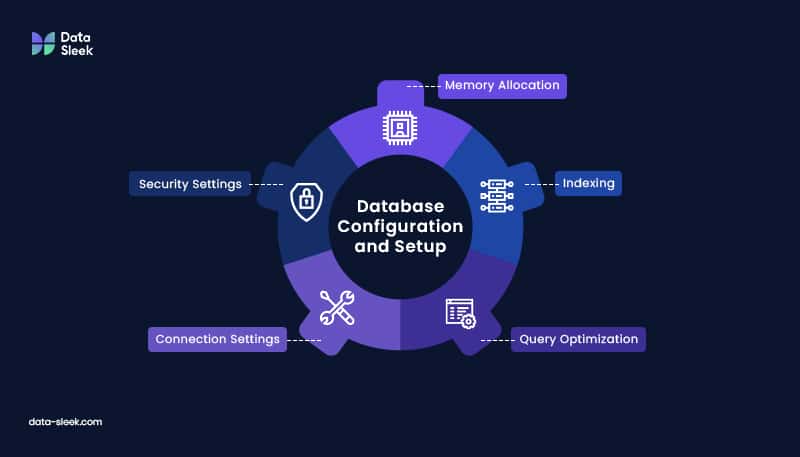Has your organization carried out an internal database audit lately? If not, it’s time to schedule regular audits. The efficiency of database systems directly impacts your organization’s productivity and success. Without regular database audits, your organization could be sitting on some hidden problems waiting to be uncovered.
From customer information and financial records to intellectual property and operational data, databases store some of your organization’s most valuable assets. With great value comes great risk—inefficient databases lead to slow applications, decreased productivity, and missed opportunities. Research estimates that poor data quality and management costs businesses an average of $12.9 million annually in losses.
Keeping your organization in top shape can be as simple—yet complex—as conducting a comprehensive database audit. But with the right knowledge and tools, you can confidently navigate this process and ensure the efficiency of your database systems.
Why Conduct A Database Audit?
Conducting a database audit is a proactive measure to address some of the most common issues in scaling, including monitoring and gathering data about specific database activities and privacy requirements. A comprehensive database audit identifies vulnerabilities and inaccuracies and pinpoints critical areas for optimization. By taking this proactive step, you can safeguard your operations from slowdowns and outages, giving you a sense of control over your systems and operations. By optimizing your databases, you enable your organization to do what it does best—and do it more efficiently.
As your company grows and succeeds, your data volumes and processes will likely become more complex. However, this growth may also lead to degraded database performance, resulting in slower applications, frustrated users, and missed opportunities. Gartner Research estimates an average revenue loss of $300,000 per hour due to database downtime and sluggish performance.
To prevent these costly setbacks, implementing an audit process is crucial, particularly within SQL server environments. By conducting regular SQL server audits, you can proactively track and log critical events, monitor database activities, and ensure your system’s security and compliance. Let’s take a closer look at how auditing inside an SQL server works and why it is an essential tool for database optimization.

What is auditing inside an SQL server?
Auditing inside an SQL server involves tracking and logging events and activities that occur within the database system. This includes monitoring actions such as logins, queries, modifications to data, schema changes, and more, often performed from a command line. Auditing helps in maintaining security, compliance with regulations, troubleshooting issues, and identifying unauthorized access or suspicious activities within the SQL server environment. This includes troubleshooting specific issues like MariaDB table locks on AWS RDS. By enabling auditing features and reviewing audit logs regularly, administrators can ensure the integrity and security of their database systems.
SQL Database Auditing
SQL database auditing is a crucial feature that helps track database-related events and maintain an audit trail of selected actions. It allows for monitoring and logging database activities to ensure security compliance. SQL database auditing provides preconfigured reports and dashboards for easy reporting on database activity, making it an essential tool for maintaining security and integrity.
Using SQL Server Audit
SQL Server audit is a powerful tool that allows you to track and log events that occur on the SQL Server database Engine. By creating server audits and database audit specifications, you can monitor server-level and database-level events efficiently. Audited events can be stored in event logs or audit files for further analysis. SQL Server audit provides a comprehensive solution for ensuring data security and compliance with regulatory requirements.

How Database Audits Benefit Your Organization
Conducting a comprehensive database audit isn’t just a maintenance task—it’s a strategic imperative that can propel your organization forward. Audits benefit your organization by helping you uncover hidden inefficiencies, optimize performance, and position your systems to support your business objectives better.
Some of these benefits include:
Enhancing Performance and Efficiency
Performance issues like slow database queries and inefficient data retrieval can wreak havoc on companies trying to scale. An estimated 70% of enterprise organizations experience application performance issues due to database problems. Optimization ensures that data is stored and accessed most efficiently.
Supporting Business Growth
As organizations scale, databases must handle increasing loads without compromising performance. IDC predicts that by 2025, the global datasphere will grow to 175 zettabytes. That is a massive data explosion—a nearly fivefold increase from 2018. Growing volumes of data require systems that can handle seamless growth.
Maximizing Resources
Scaling businesses must be mindful of where they allocate resources, whether cash, human capital, or tech. Efficient databases make better use of resources by reducing the need for additional investments in infrastructure, hiring extra staff to manage poor-quality data, and implementing costly and unnecessary data management systems. Regular audits cut costs and help maximize your return on investments.
Improving Decision-Making
Faster data processing enables real-time analytics and reporting to empower your decision-makers with timely insights. This agility can be a make-or-break factor in maintaining your competitive edge in a cutthroat market.
Beyond speed, data accuracy plays another critical role in the game. Stakeholders need assurance that the data they are working off of is as accurate as possible. Minimizing risk and maximizing returns starts and ends with accuracy, which can only be achieved by regular auditing.
Improving Customer Satisfaction
In customer-facing applications, performance is critical. Optimized databases ensure that applications run smoothly while reducing downtime. Studies conducted by Amazon demonstrated a 1% loss in annual revenue per 100-millisecond delay in page load time. For the average enterprise organization, 1% of annual revenue would be $39.3 million.
Maintaining Regulatory Compliance
A database audit is an essential practice for regulatory compliance, ensuring that organizations adhere to specific standards and regulations set by governing bodies. By auditing, companies can track and monitor activity, detect any anomalies or discrepancies that may indicate security risks or compliance issues. Through auditing, organizations can enforce strong internal controls to meet regulatory compliance requirements.
Part of maintaining regulatory compliance includes identifying any vulnerabilities in user access and data access. By monitoring data access, organizations can ensure data security, identify unauthorized access or data breaches, and maintain compliance with data protection regulations like GDPR. This level of visibility is crucial for maintaining data integrity and protecting sensitive information from unauthorized access.
In many cases, it legally required to conduct audits and keep detailed audit logs. An audit record outlining checks on sensitive data such as a patient’s health historical information ensures regulations are being met adequately.

The Database Optimization Audit Process
Optimizing your database systems requires a systematic and thorough approach to identify performance bottlenecks and implement effective solutions. The database optimization audit process is designed to evaluate your current systems comprehensively and enhance their efficiency.
It’s important to note that each organization has unique processes and goals. Because of this, an audit might look different in your organization. The general process of database audits follows the following steps.
1. Discovery Process
The first step involves clearly defining objectives focused on performance improvements, scalability, and efficiency. Determining the scope is equally important. Identifying which databases and applications will be included gives clear insight into the breadth and depth of the audit.
2. Data Collection
This phase involves inventorying all database servers, instances, and relevant hardware components. An accurate inventory helps identify underutilized resources, which can reduce costs by up to 30%. Gathering performance data–such as query execution times and transaction logs–gives a detailed look into the current state of your databases.
3. Carrying Out A Performance Assessment
After collecting data, your databases must undergo several critical evaluations, including:
- Analyzing queries to identify slow-running queries and pinpoint inefficiencies.
- Evaluate indexing strategies to assess the effectiveness of existing indexes and identify new opportunities.
- Review schema design to examine schemas for normalization, redundancy, and structural issues impacting performance.
- Review security and compliance measures to ensure your organization complies with all regulations and safety standards.
4. Resource Utilization Analysis
Monitoring resource consumption helps to identify any existing bottlenecks in your organization’s data. CPU and memory usage are common, contributing to system slowdowns. Disk performance is another common issue involving read/write speeds and storage configurations.
5. Making Optimization Recommendations
Based on the assessments, an audit will produce targeted recommendations. Depending on the results, recommendations might include:
- Query Optimization: To rewrite inefficient queries to reduce CPU usage and improve response times.
- Index Optimization: Create, modify, or remove indexes to improve data retrieval times from minutes to a fraction of a second.
- Schema Refinement: Adjusting database schemas eliminates redundancies and enhances data integrity.
- Hardware and Configuration Tweaks: This includes recommended changes to hardware setups or configurations for optimal performance.
6. Implementation and Monitoring
Of course, a database audit is only helpful if the organization makes necessary changes. Execution and continuous oversight are crucial, which is why we recommend that any changes or optimizations occur in a controlled environment, including the operating system. We also recommended adequate and thorough performance testing to ensure the changes net the proper results and keep an detailed audit record. Remember, audits are not a one-and-done thing. We recommend ongoing monitoring to maintain performance levels and ensure your databases are in peak shape.
What Are Some Common Techniques Used in Database Optimization Audits?
An effective database optimization audit employs several techniques to target performance and efficiency. Techniques include query optimization, index management, hardware and configuration tuning, and database schema optimization.
- Query Optimization: Queries are commands used to retrieve data from your database. Some queries can become inefficient over time and cause slow response times. Analyzing and rewriting these queries can speed up data retrieval and system load.
- Index Management: Indexes function similarly to a book’s index. Creating the proper indexes can dramatically speed up data retrieval. On the other hand, having unnecessary or redundant indexes can slow down operations and worsen the situation. Regularly reviewing and managing indexes ensures your database operates efficiently.
- Hardware and Configuration Tuning: Performance issues aren’t always about the data but the hardware and configurations they’re running on. Adjusting your memory allocations, upgrading storage, and even changing storage providers altogether can lead to significant improvements. Data-Sleek recommends thoroughly vetting your data storage providers and planning for the long run to avoid scalability challenges that can derail your business.
- Database Schema Optimization: Optimizing the schema involves structuring your data to reduce redundancy and improve integrity. Techniques like normalization eliminate duplicate data, enhance data quality, and make your database more efficient.

What Are Some Common Pitfalls to Avoid When Conducting A Database Audit?
Some common pitfalls when conducting a database audit include a lack of clear objectives and scope, insufficient understanding, poor documentation, objectivity and biases, and inadequate training.
Organizations conducting their internal audits must be mindful of the risks and proactively put measures in place to mitigate them.
Lack of clear objectives and scope
Without well-defined objectives, the audit team may spend time on irrelevant areas while missing critical ones. Unfocused efforts can lead to higher costs and missed expectations, further worsening performance problems.
Avoidance Strategy: Define specific goals and set clear boundaries. Document and communicate your plan to both the audit team and stakeholders. Conduct regular reviews to ensure the audit stays on course.
Insufficient Understanding of the Environment
Each database environment has unique features, configurations, and potential weaknesses. A deep understanding is essential to identify all relevant risks and provide actionable recommendations. Auditors lacking the technical knowledge to audit the databases effectively will likely produce inaccurate reports. As a result, their suggestions may not be practical or even relevant.
Avoidance Strategy: Ensure the audit team knows their stuff. Organizations that don’t have a team well-versed in the specific technologies used–or how to solve the problems once identified–should consider consulting with Database Administrators (DBAs).
Generating Poor Documentation (Or None At All)
Thorough documentation is essential for transparency, accountability, and facilitating follow-up actions. It serves as a reference point for future audits, including Windows Security event logs, and helps demonstrate compliance to regulators. Not leaving an audit trail makes it difficult to verify what was assessed, what conclusions were reached, and what corrective actions were taken to address those issues.
Avoidance Strategy: Use standardized templates for recording findings, methodologies, and evidence collected. Leave detailed records on every step of the audit process. Keep them organized and stored in a secure, accessible location.
Dealing with Objectivity and Biases
Objectivity is vital to ensure the audit findings are accurate, reliable, and credible. Biases can lead to overlooked vulnerabilities, non-compliance, and a false sense of security. Auditors who are part of the team may unconsciously (or consciously) overlook issues to present their work in a favorable light. Confirmation biases and partial assessments are other areas that can significantly skew audit results.
Avoidance Strategy: Using external auditors is the safest, most effective way to ensure your audits are accurate and reliable. Professional data management consultants include team members the necessary training and expertise to carry out audits thoroughly and effectively. They bring an objective and unbiased perspective to the audit process, a key component of our database consulting services.
Inadequate Training
Well-trained auditors are essential for a thorough and effective audit. They must be knowledgeable about current technologies, threats, and regulatory changes to provide valuable insights and recommendations. Auditors lacking the necessary technical skills can miss critical issues during auditing. Without up-to-date knowledge, auditors can put your organization at risk by missing critical compliance requirements along the way.
Avoidance Strategy: Provide your organization’s audit team with ongoing training programs and certifications. Invest in your team by allocating sufficient budget and time for these development activities.

Why Should You Hire an External Database Auditor?
Hiring an external database auditor offers more than peace of mind; it provides your organization with specialized expertise and experience, an objective and unbiased perspective, and more. To learn more about the benefits of database consulting service, we have a dedicated article to help you.
Some of these benefits include:
- Specialized Expertise and Experience: External auditors work with multiple clients across different industries. They can often spot an error a lot quicker and more acutely than the average internal audit team. As a result, they have an in-depth understanding of various systems and performance-tuning techniques and are up-to-date on the latest industry best practices.
- Following Best Practices: Following regulations and maintaining compliance includes proper documentation. An external auditor can provide your organization with audit information such as audit logs or an audit record that can be used to show proof of compliance.
- Unbiased and Objective Perspectives: External auditors are more likely to identify inefficiencies and bottlenecks that internal teams might overlook due to familiarity and tunnel vision. They also have no reason to skew or overlook issues during an evaluation. Instead, they provide a fresh, impartial assessment of your database.
- Cost Savings Beyond the Audit: Experienced consultants have an in-depth understanding of the market and major database solutions. They can help your organization identify key areas to address while making recommendations to save your organization losses over time. Hiring an external auditor reduces the investment needed to train and upkeep internal teams, freeing up capital to help fuel your organization’s growth.
- Tailored Recommendations: External auditors analyze your specific environment and business requirements to develop optimization plans that fit your unique needs. While your organization might focus on the short term, external auditors consider future growth. They can offer recommendations that ensure optimization efforts support long-term objectives.

Ready for Your Next Database Audit? Let Data-Sleek Handle It
Optimizing your performance and efficiency is crucial for sustaining growth and maintaining a competitive edge. Data-Sleek offers expert external auditing and comprehensive database management services. With specialized knowledge and objective insights, our team can identify inefficiencies and implement tailored solutions to your organization’s needs.
Why Choose Data-Sleek?
- Expertise: Our professionals have extensive experience in database optimization across various industries.
- Customized Solutions: We develop strategies tailored to your organization’s specific needs and goals.
- Proven Results: Our optimization efforts have helped clients improve performance, reduce costs, and support business growth.
Take the Next Step
Contact us today to learn how our optimization services can support your business objectives and propel your organization forward. Let us help you unlock the full potential of your data.
Frequently Asked Questions
How often should database audits be conducted?
The frequency of audits largely depends on your organization’s needs, industry regulations, and the complexity of your systems. However, as a general guideline, audits should be conducted at least once a year to ensure optimal performance and security. In highly regulated industries, such as finance or healthcare, quarterly or even monthly audits may be required to comply with industry standards and avoid potential risks. Additionally, audits should be conducted whenever there are significant system changes, such as large-scale migrations, updates, or infrastructure changes, to ensure everything is functioning efficiently and securely post-implementation.
Can database auditing impact system performance?
Yes, database auditing can affect system performance, especially if extensive logging is enabled. However, by configuring selective auditing—focusing on critical actions—administrators can minimize any performance impact while maintaining security and compliance.
How does a database audit help ensure data security and integrity?
A database audit helps ensure data security and integrity by monitoring and tracking all activities and changes made, including changes to security settings. It provides a detailed record of who accessed, what changes were made, and when they occurred. By reviewing these audit logs, administrators can identify any unauthorized access attempts, suspicious activities, or potential security breaches. Additionally, audits help enforce compliance with regulations and internal policies by ensuring that data is being handled appropriately and securely. Regularly conducting audits can help organizations maintain the confidentiality, integrity, and availability of their data, ultimately enhancing overall data security measures.
How does compliance with regulations play a role in database audits?
Compliance with regulations plays a crucial role in database audits as it ensures that organizations meet the legal requirements governing the handling and protection of data, such as the Japan privacy law. By adhering to regulations such as GDPR, HIPAA, or PCI DSS, businesses can demonstrate their commitment to safeguarding sensitive information, maintaining data integrity, and protecting user privacy.



